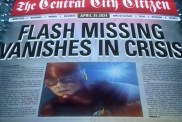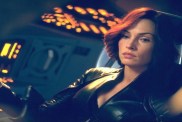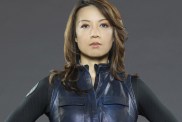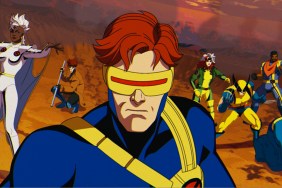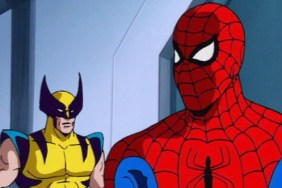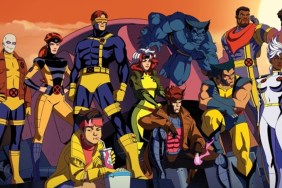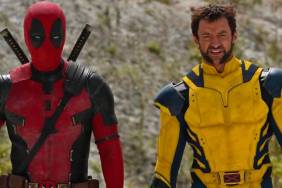
Back in March, we debuted the first in a new article series “From Comics to Movies,” focusing on the visual language of Christopher Nolan’s The Dark Knight trilogy and the inspirations that it took from its comic book basis. Now, we have the next entry in the series focusing on 20th Century Fox’s long-running “X-Men” franchise, though this one will be a little bit different in some cases.
Something that is easy to forget about the “X-Men” films is that it’s the current longest-running comic book film franchise. The series got its start with the first film in the year 2000 and despite attempts at rebooting or reshuffling the continuity, it has remained a singular (mostly intact) franchise. Looking back at the start of the series, it began in a time when comic book movies didn’t adapt specific story lines from the source material and instead chose to focus on aesthetics and characters with an original story formed around them. Bryan Singer‘s original X-Men has moments that can be found in comics, but overall its narrative is a unique construct.
That changed with the sequel, X2, which takes elements from the graphic novel X-Men: God Loves, Man Kills, and combined it with the second arc of Ultimate X-Men, a series that launched just seven months after the first film opened. They would continue this tradition with X-Men: The Last Stand, combining the “Gifted” arc from Joss Whedon and John Cassaday’s Astonishing X-Men with the fan-favorite Dark Phoenix story line, and X-Men Origins: Wolverine by combining Origin with the “Weapon X” arc.
X-Men: First Class is an interesting departure as it shares a name with a number of comics but has little to do with any of them and is once again a mostly original plot. 2013’s The Wolverine is at its core an adaptation of the Chris Claremont/Frank Miller Wolverine series, with other elements tossed in, and last year’s X-Men: Days of Future Past, while sharing a name with the most popular story in X-Men history, is pretty different overall. All of that is to say that there are certainly instances in the “X-Men” films where the shots in them align with the comics, but some of the slides we’ve included aren’t direct visual matches. Some of what you’ll find below are the scenes in comics from where the film took narrative inspiration, a kernel of a story that was mutated into what was needed for the script.
Check out the slideshow and compare the comic book panels with shots from the movies, and let us know your thoughts below!
Click Full Screen to see the full images!
Comics to movie: X-Men
-
X-Men (2000)

Magneto: The Twisting of a Soul - 1993
"Magneto Seminar"Written by Fabian Nicieza
Pencils by Jan Duursema
Inks by Dan Panosian -
X-Men (2000)

Classic X-Men #12 - 1987
"A Fire in the Night!"Written by Chris Claremont
Pencilers and inks by John Bolton -
X-Men (2000)

Uncanny X-Men #141 - 1981
Written by Chris Claremont & John Byrne
Pencils by John Byrne
Inks by Terry Austin
Colors by Glynis Wein -
X-Men (2000)

Uncanny X-Men #141 - 1981
Written by Chris Claremont & John Byrne
Pencils by John Byrne
Inks by Terry Austin
Colors by Glynis Wein -
X-Men (2000)

Uncanny X-Men #273 - 1991
Written by Chris Claremont
Pencils by Michael Golden
Inks by Scott Williams
Colors by Joe Rosas -
X-Men (2000)

Uncanny X-Men #222 - 1987
Written by Chris Claremont
Pencils by Marc Silvestri
Inks by Dan Green
Colors by Glynis Oliver -
X-Men (2000)

Uncanny X-Men #213 - 1987
Written by Chris Claremont
Pencils by Alan Davis
Inks Paul Neary
Colors by Glynis Oliver -
X2: X-Men United (2003)

Wolverine #48 - 1991
Written by Larry Hama
Pencils by Marc Silvestri
Inks by Dan Green
Colors by Steve Bucellato -
X2: X-Men United (2003)

Ultimate X-Men #8 - 2001
Written by Mark Millar
Pencils by Adam Kubert
Inks by Art Thibert
Colors by Jung Choi -
X2: X-Men United (2003)

Ultimate X-Men #8 - 2001
Written by Mark Millar
Pencils by Adam Kubert
Inks by Art Thibert
Colors by Jung Choi -
X2: X-Men United (2003)

Ultimate X-Men #8 - 2001
Written by Mark Millar
Pencils by Adam Kubert
Inks by Art Thibert
Colors by Jung Choi -
X2: X-Men United (2003)

Ultimate X-Men #8 - 2001
Written by Mark Millar
Pencils by Adam Kubert
Inks by Art Thibert
Colors by Jung Choi -
X2: X-Men United (2003)

X-Men: God Loves, Man Kills - 1982
Written by Chris Claremont
Pencils and Inks by Brent Anderson
Colors by Steve Oliff -
X2: X-Men United (2003)

X-Men: God Loves, Man Kills - 1982
Written by Chris Claremont
Pencils and Inks by Brent Anderson
Colors by Steve Oliff -
X2: X-Men United (2003)

Wolverine #48 - 1991
Written byLarry Hama
Pencils by Marc Silvestri
Inks by Dan Green
Colors by Steve Bucellato -
X2: X-Men United (2003)

X-Men: God Loves, Man Kills - 1982
Written by Chris Claremont
Pencils and Inks by Brent Anderson
Colors by Steve Oliff -
X2: X-Men United (2003)

Uncanny X-Men #205 - 1986
Written by Chris Claremont and Barry Windsor-Smith
Pencils, Inks & Colors by Barry Windsor-Smith -
X2: X-Men United (2003)

Uncanny X-Men #205 - 1986
Written by Chris Claremont and Barry Windsor-Smith
Pencils, Inks & Colors by Barry Windsor-Smith -
X2: X-Men United (2003)

Uncanny X-Men #205 - 1986
Written by Chris Claremont and Barry Windsor-Smith
Pencils, Inks & Colors by Barry Windsor-Smith -
X-Men: The Last Stand (2006)

Astonishing X-Men #6 - 2004
Written by Joss Whedon
Pencils and Inks by John Cassaday
Colors by Laura Martin -
X-Men: The Last Stand (2006)

Astonishing X-Men #6 - 2004
Written by Joss Whedon
Pencils and Inks by John Cassaday
Colors by Laura Martin -
X-Men: The Last Stand (2006)

Astonishing X-Men #1 - 2004
Written by Joss Whedon
Pencils and Inks by John Cassaday
Colors by Laura Martin -
X-Men: The Last Stand (2006)

Astonishing X-Men #2 - 2004
Written by Joss Whedon
Pencils and Inks by John Cassaday
Colors by Laura Martin -
X-Men: The Last Stand (2006)

Astonishing X-Men #3 - 2004
Written by Joss Whedon
Pencils and Inks by John Cassaday
Colors by Laura Martin -
X-Men: The Last Stand (2006)

Astonishing X-Men #3 - 2004
Written by Joss Whedon
Pencils and Inks by John Cassaday
Colors by Laura Martin -
X-Men: The Last Stand (2006)

Excalibur #3 - 1988
Written by Chris Claremont
Pencils by Alan Davis
Inks by Paul Neary
Colors by Glynis Oliver -
X-Men: The Last Stand (2006)

Astonishing X-Men #1 - 2004
Written by Joss Whedon
Pencils and Inks by John Cassaday
Colors by Laura Martin -
X-Men: The Last Stand (2006)

Uncanny X-Men #136 - 1980
Written by Chris Claremont and John Byrne
Pencils by John Byrne
Inks by Terry Austin
Colors by Bob Sharen -
X-Men Origins: Wolverine (2009)

Origin #2 - 2001
Written by Paul Jenkins
Pencils and Inks by Andy Kubert
Colors by Richard Isanove -
X-Men Origins: Wolverine (2009)

Origin #2 - 2001
Written by Paul Jenkins
Pencils and Inks by Andy Kubert
Colors by Richard Isanove -
X-Men Origins: Wolverine (2009)

Origin #2 - 2001
Written by Paul Jenkins
Pencils and Inks by Andy Kubert
Colors by Richard Isanove -
X-Men Origins: Wolverine (2009)

Marvel Comics Presents #73 - 1991
"Weapon X (Chapter One)"Written, Pencils, Inks and Colors by Barry Windsor-Smith
-
X-Men Origins: Wolverine (2009)

Marvel Comics Presents #73 - 1991
"Weapon X (Chapter One)"Written, Pencils, Inks and Colors by Barry Windsor-Smith
-
X-Men Origins: Wolverine (2009)

Marvel Comics Presents #73 - 1991
"Weapon X (Chapter One)"Written, Pencils, Inks and Colors by Barry Windsor-Smith
-
X-Men Origins: Wolverine (2009)

Marvel Comics Presents #77 - 1991
"Weapon X (Chapter Five)"Written, Pencils, Inks and Colors by Barry Windsor-Smith
-
X-Men Origins: Wolverine (2009)

Marvel Comics Presents #80 - 1991
"Weapon X (Chapter Eight)"Written, Pencils, Inks and Colors by Barry Windsor-Smith
-
X-Men: First Class (2011)

New X-Men #118 - 2001
Written by Grant Morrison
Pencils by Ethan van Sciver
Inks by Prentiss Rollins, Scott Hanna, Sandu Florea
Colors by Hi-Fi Design -
X-Men: First Class (2011)

X-Men #1 - 1963
Written by Stan Lee
Pencils by Jack Kirby
Inks by Paul Reinman -
The Wolverine (2013)

Wolverine #1 - 1982
Written by Chris Claremont
Pencils by Frank Miller
Inks by Josef Rubinstein
Colors by Glynis Wein -
The Wolverine (2013)

Wolverine #1 - 1982
Written by Chris Claremont
Pencils by Frank Miller
Inks by Josef Rubinstein
Colors by Glynis Wein -
The Wolverine (2013)

Wolverine #1 - 1982
Written by Chris Claremont
Pencils by Frank Miller
Inks by Josef Rubinstein
Colors by Glynis Wein -
The Wolverine (2013)

Wolverine #1 - 1982
Written by Chris Claremont
Pencils by Frank Miller
Inks by Josef Rubinstein
Colors by Glynis Wein -
The Wolverine (2013)

Wolverine #1 - 1982
Written by Chris Claremont
Pencils by Frank Miller
Inks by Josef Rubinstein
Colors by Glynis Wein -
The Wolverine (2013)

Wolverine #1 - 1982
Written by Chris Claremont
Pencils by Frank Miller
Inks by Josef Rubinstein
Colors by Glynis Wein -
The Wolverine (2013)

Wolverine #1 - 1982
Written by Chris Claremont
Pencils by Frank Miller
Inks by Josef Rubinstein
Colors by Glynis Wein -
The Wolverine (2013)

Wolverine #1 - 1982
Written by Chris Claremont
Pencils by Frank Miller
Inks by Josef Rubinstein
Colors by Glynis Wein -
The Wolverine (2013)

Wolverine #1 - 1982
Written by Chris Claremont
Pencils by Frank Miller
Inks by Josef Rubinstein
Colors by Glynis Wein -
The Wolverine (2013)

Wolverine #3 - 1982
Written by Chris Claremont
Pencils by Frank Miller
Inks by Josef Rubinstein
Colors by Glynis Wein -
The Wolverine (2013)

Wolverine #4 - 1982
Written by Chris Claremont
Pencils by Frank Miller
Inks by Josef Rubinstein
Colors by Glynis Wein -
The Wolverine (2013)

Wolverine #4 - 1982
Written by Chris Claremont
Pencils by Frank Miller
Inks by Josef Rubinstein
Colors by Glynis Wein -
The Wolverine (2013)

Wolverine #4 - 1982
Written by Chris Claremont
Pencils by Frank Miller
Inks by Josef Rubinstein
Colors by Glynis Wein -
The Wolverine (2013)

Wolverine #4 - 1982
Written by Chris Claremont
Pencils by Frank Miller
Inks by Josef Rubinstein
Colors by Glynis Wein -
The Wolverine (2013)

Wolverine #4 - 1982
Written by Chris Claremont
Pencils by Frank Miller
Inks by Josef Rubinstein
Colors by Glynis Wein -
The Wolverine (2013)

Wolverine #3 - 1982
Written by Chris Claremont
Pencils by Frank Miller
Inks by Josef Rubinstein
Colors by Glynis Wein -
The Wolverine (2013)

Wolverine #3 - 1982
Written by Chris Claremont
Pencils by Frank Miller
Inks by Josef Rubinstein
Colors by Glynis Wein -
The Wolverine (2013)

Uncanny X-Men #173 - 1983
Written by Chris Claremont
Pencils by Paul Smith
Inks by Bob Wiacek
Colors by Glynis Wein -
The Wolverine (2013)

Uncanny X-Men #173 - 1983
Written by Chris Claremont
Pencils by Paul Smith
Inks by Bob Wiacek
Colors by Glynis Wein -
X-Men: Days of Future Past (2014)

Uncanny X-Men #141 - 1981
Written by Chris Claremont & John Byrne
Pencils by John Byrne
Inks by Terry Austin
Colors by Glynis Wein -
X-Men: Days of Future Past (2014)

Uncanny X-Men #141 - 1981
Written by Chris Claremont & John Byrne
Pencils by John Byrne
Inks by Terry Austin
Colors by Glynis Wein -
X-Men: Days of Future Past (2014)

Uncanny X-Men #141 - 1981
Written by Chris Claremont & John Byrne
Pencils by John Byrne
Inks by Terry Austin
Colors by Glynis Wein -
X-Men: Days of Future Past (2014)

Uncanny X-Men #142 - 1981
Written by Chris Claremont & John Byrne
Pencils by John Byrne
Inks by Terry Austin
Colors by Glynis Wein -
X-Men: Days of Future Past (2014)

Uncanny X-Men #142 - 1981
Written by Chris Claremont & John Byrne
Pencils by John Byrne
Inks by Terry Austin
Colors by Glynis Wein -
X-Men: Days of Future Past (2014)

Uncanny X-Men #141 - 1981
Written by Chris Claremont & John Byrne
Pencils by John Byrne
Inks by Terry Austin
Colors by Glynis Wein
